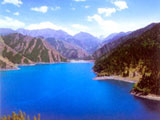 The Aksu region is located on the southern piedmont of the imposing Tianshan Mountains, and northern rim of the vast Taklamakan Desert. During the Han Dynasty era 2,000 years ago, the region was a key point on the ancient Silk Road, and saw countless merchants from many Asian countries as well as Europe passing through.
The Aksu region is located on the southern piedmont of the imposing Tianshan Mountains, and northern rim of the vast Taklamakan Desert. During the Han Dynasty era 2,000 years ago, the region was a key point on the ancient Silk Road, and saw countless merchants from many Asian countries as well as Europe passing through.
Aksu’s long history has left it with an abundance of historical sites and a rich
cultural legacy. Of greatest historical interest are the Kizil Thousand-Buddha Caves, one of the earliest and largest groups of Buddhist grottoes in China.
There are some 240 caves at Kizil, all scattered around high mountain precipices in Baicheng County. Digging started in the late third century, and their construction continued for five centuries until Islam was introduced into China, leading to the decline of Buddhism in the Xinjiang region.
The grottoes here are best known for their wonderfully colorful murals, which stretch for ten thousand square meters in area. They are highly acclaimed for the superb techniques employed in the paintings, most of which feature Buddhist themes. In one of the caves you can find a narrative sequence of pictures portraying the life of Buddha from his birth to his enlightenment. In addition to religious matter, there are also paintings depicting the daily activities of the local people, such as farming, hunting, trading and dancing. The murals are not only invaluable for the study of Buddhist culture, but also allow people today to gain an insight into the lives of the Uygur people and other ethnic groups living in Xinjiang centuries ago.
Another famous historical site in Aksu is the Subash Temple in Kuche County, the largest ruins of a Buddhist temple ever discovered in Xinjiang. Built of adobe in the third century, the temple is made of two parts that are located on both sides of the Kuche River. The eastern part of the temple is built on a mountain slope, inside which stand three pagodas. Climbing onto the tallest pagoda, one can get a bird’s-eye view of the whole temple complex. The western part of the temple is square in shape and is surrounded by ten-meter-high walls. It’s where the main buildings are located, such as the Buddha-worshipping halls, meditation halls and monks’ dwellings.
In ancient times, Aksu served as an important political, economic and cultural center for the Xinjiang area. It used to be home to a number of city kingdoms. Some of the ruins of these kingdoms can still be found today, such as the ancient cities of Qiuci and Tongusbash. A visit to these ruins will take you back in time to see the former prosperity and glory of the Aksu region.
In addition to its long history and magnificent culture, Aksu is also blessed with magnificent landscapes. In the Ugyur language, the word Aksu means ‘clear waters’. Indeed, the region is rich in water resources such as rivers, streams and lakes. The Tarim River, where three tributaries from the Tianshan and Karakorum mountains meet, is the longest inland river in China. The local people have given it the nickname “runaway horse”, as the water volume varies greatly with the change of seasons. In spring, when the mountain snow and glaciers melt, the gentle river bursts into rapid torrents running through the southern part of the Aksu region, offering a breathtaking spectacle for both the eyes and ears.
Hidden deep in the majestic Tianshan Mountains is a blue lake called the Big Dragon Lake. Legend has it that the Queen Mother of the West often bathes herself in it.
Covering an area of two square kilometers, the lake is famous for its enchanting beauty. Under blue and clear skies, the lake’s surface is as limpid as a mirror, and reflects the snow-capped mountains as well as the evergreens and flocks of sheep and cattle on its slopes.
To the west of the Tianshan mountains lies another tourist attraction called the Tomur Nature Reserve. It’s named after the snow and clouds covering Tomur Peak. At 7,400 meters above sea level, Tomur is the highest peak in the Tianshan Mountains. Massive glaciers, deep valleys and caves, luxuriant forests, green meadows as well as countless species of rare plants and animals combine to form the beautiful and spectacular world of the nature reserve.
Aksu has a population of some two million, most of whom are Uygur people. After trekking through the many historical sites and scenic places, enjoying the beautiful and unique music and dances of the local people is without doubt the best way to relax.
And when you leave, don’t forget to bring some local specialties with you, such as the walnuts and preserved fruits. And local handicrafts such as the exquisitely made purses and silk scarves not only make for good souvenirs, but are also ideal gifts for friends.
(CRI October 24, 2002)
|

